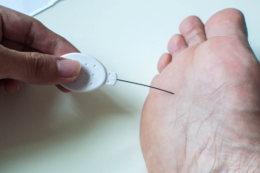Tagged with #diabeticfoot …
How To Manage Blood Sugar for Healthy Feet
One common complication of having diabetes is foot problems. High glucose levels can cause nerve damage and poor blood circulation, which may lead to numbness, sores, and ulcers on the feet. If these conditions become severe, they can result in more serious issues, including foot deformities or amputations.
Hence, it’s crucial to manage your blood sugar. Aside from keeping your diabetes under control, doing so will also help prevent potential diabetic foot problems. Here’s what you should do:
Stay Active
Exercising on a regular basis is beneficial if you have diabetes as it makes your body more sensitive to insulin, lowering your blood sugar. It also helps reduce risks of cardiovascular diseases and reduce stress, which typically causes your glucose levels to spike up.
You don’t need an intense workout routine to stay active. Simply making a habit of walking at least 25-30 minutes a day is enough. You may also consider swimming or upper body workouts if you want to keep your heart rate up without putting too much strain on your feet.
Consume More Whole Foods
A healthy diet makes a huge difference if you want to manage your diabetes. Aside from limiting sugar and carb intake, adding fiber-rich and whole foods to your diet, like leafy greens, fruits, and whole grains, is best. Make sure to hydrate with water instead of choosing sodas or sugary drinks.
Stop Smoking
Apart from an increased risk for conditions like heart disease and stroke, using tobacco also affects how your body controls your blood sugar. Because of this, those who smoke are more likely to develop type 2 diabetes. If you need to quit, consider other nicotine replacements like patches, or talk to your doctor for the best action plan.
Ensure Routine Checkups
In addition to making a few lifestyle changes to control your glucose levels, it’s essential to visit your doctor regularly. A routine checkup allows you to keep track of your diabetes and medication and get professional advice on your diet and exercise.
It’s best to visit your foot doctor at least once a year. They can check for signs of potential foot problems through various tests and assessments and perform the necessary treatments. Your podiatrist may also provide more information on managing diabetic foot symptoms and proper foot care.
Consult a Diabetic Foot Specialist
Learning how to manage your blood sugar is one way you can prevent diabetic feet. Doing so also helps alleviate pain and other symptoms if you already have foot problems caused by diabetes. For a routine checkup or a diabetic foot treatment, reach out to Thomas Podiatry & Associates in Salisbury, MD today.
How To Manage Symptoms of Diabetic Feet
When you have high glucose levels, you are more likely to develop foot diseases such as diabetic neuropathy and peripheral vascular disease. These conditions may cause numbness, pain, tingling, increased risk of infections, and slow-healing injuries.
Aside from the discomfort, diabetic foot problems can also affect your daily life, as they may prevent proper stability and functionality of your feet. So, it’s best to learn how to manage and ease these symptoms. Here are some tips to help you:
Check Your Feet Daily
When you have diabetes, you may experience numbness in your feet, which prevents you from feeling cuts or scratches. So, it’s crucial to inspect them every day. If you do so, you can treat your feet immediately and prevent potential infections from occurring. It would be best if you also looked out for blisters, ingrown toenails, or any signs of swelling, redness, or sore spots. If you find any, talk to your foot doctor.
Wear Proper Footwear
Choosing the right well-fitting footwear lessens the risk of blisters and calluses forming on your feet. So, it’s best to do a foot measurement on your own or with the help of a professional whenever you’re buying new shoes. You should also avoid wearing high heels or pointed shoes since they may put excess strain on the front of your feet.
Monitor Your Blood Sugar
Since high glucose levels are the main reason for diabetic foot issues, keeping them under control is essential. You can do so by maintaining a healthy diet, checking your blood sugar, and taking the necessary medications prescribed by your doctor.
Exercise Regularly
Staying active is greatly beneficial if you have diabetes. Doing so helps improve blood circulation and control your blood sugar levels, easing pain caused by a foot disease. You may start with a regular walking routine or consult your podiatrist on the best form of exercise for your condition.
Stop Smoking
Among the negative effects of smoking is poor blood circulation, which can increase your risk of diabetic foot disease. So, it’s best to break the habit as early as possible if you are a smoker. If you find it difficult, consider a tobacco cessation program.
Consult a Foot Doctor Near You
Now that you know about these tips, you can prevent symptoms of diabetic foot problems from worsening. If you experience unusual pain or want a professional assessment, reach out to Thomas Podiatry & Associates in Salisbury, MD. Our physicians will gladly assist you with your diabetic foot care needs.







